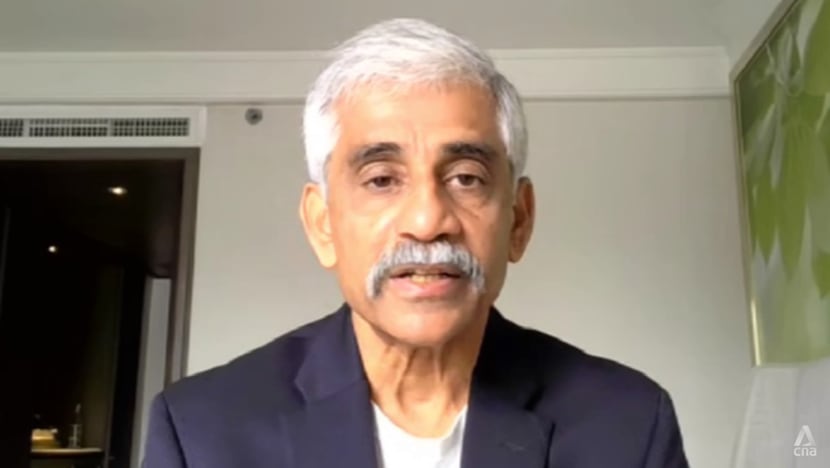Asia Pacific aviation on track to meet 5% sustainable fuel target: Industry body
Governments need to enforce policies to accelerate sustainable aviation fuel production and adoption, says the Association of Asia Pacific Airlines' director general Subhas Menon during an interview with CNA’s Yasmin Jonkers.


This audio is generated by an AI tool.
BANGKOK: Governments across Asia Pacific are taking proactive steps to help airlines make aviation more sustainable, the director general of the Association of Asia Pacific Airlines (AAPA) said.
Speaking to CNA in Bangkok last week, Subhas Menon said the trade body is confident its members are on track to hit a goal of using 5 per cent sustainable aviation fuel (SAF) by the end of the decade.
AAPA leaders in 2023 pledged to strive for a SAF utilisation target of 5 per cent by 2030.
The trade association represents airlines based in the Asia Pacific. It currently has 18 members, including Singapore Airlines, Japan Airlines, Thai Airways, Malaysia Airlines and Air India.
“Asia Pacific is growing at a very fast pace. (The region’s) governments are determined to support this growth, because aviation plays a big part in their economies, I think we'll get there,” Menon said.
“(They) are working … with their airlines, fuel suppliers, manufacturers and airports to achieve that target. Most of these governments have got their (sustainable) fuel suppliers on the ready.”
GOVERNMENTS STEP UP ON SUSTAINABILITY
Menon noted that an increasing number of governments in the region are introducing policies and regulations aimed at supporting the industry’s sustainability targets.
They include encouraging the adoption of cleaner jet fuels to promoting technological innovation and collaboration among sectors.
Singapore, for example, implemented an SAF levy last week. Airline passengers departing from Singapore will have to pay duties ranging from S$1 (US$0.77) to S$41.60 per ticket, depending on their travel destination and travel class.
Singapore also aims for SAF to account for 1 per cent of all jet fuel next year, rising to 3 to 5 per cent by 2030.
Menon said there is a need for governments to enforce policies and regulations to accelerate SAF production and adoption because high costs, limited infrastructure and market uncertainty make it difficult for the private sector to scale up on its own.
“It’s very important for governments to be proactive. Most people would say yes … to addressing emissions, but what people say and what people do sometimes differ,” he said.
“Unless there is a trigger, a call to action, people don't really act. (Singapore’s SAF) levy is (that) call to action and gives people an opportunity to participate in the greening of the planet.”
Indonesia, Southeast Asia’s most populous country, is considering a regulation to require international flights from Jakarta and Bali use a 1 per cent SAF blend from next year, gradually increasing to 5 per cent by 2035.
Malaysia is targeting a 47 per cent SAF blending mandate by 2050, and is looking to build domestic production, blending and supply of the fuel.
Japan has mandated that its refiners must supply SAF equivalent to 10 per cent of their aviation fuel sales by 2030.
EXTERNAL HEADWINDS & RESILIENT DEMAND
Most aviation experts agree that sustainable jet fuel is currently the most feasible path to greener skies as it can be used with existing aircraft and airport infrastructure.
Such fuel is made from renewable or waste-based materials instead of petroleum. It can come from biofuels derived from crops, waste-based sources like used cooking oil, or synthetic e-fuels made by combining captured carbon with hydrogen.

However, its availability remains severely limited – the commodity accounted for just 0.3 per cent of global jet fuel production in 2024.
As such, Menon said advancing technology to enhance efficiency is also a crucial part of the industry’s roadmap towards net-zero emissions.
But while there have been significant gains in emissions reductions through technology, supply chain issues – including bottlenecks in aircraft, engine and component production and delivery – have slowed progress, he said.
Furthermore, tariffs – particularly those from United States President Donald Trump – are expected to spur inflation and undermine supply chain recovery, he added
Industry groups representing global aerospace companies have already warned that such duties could jeopardise air safety or trigger other unintended consequences.
“Chief among … troubling developments in the external environment … are tariffs, (which) can do a lot of damage. In spite of that, we expect that (air travel) demand will continue to grow,” Menon said.
What was once described as “revenge travel” – a buzzword coined in 2021 to capture the surge in pent-up demand for vacations after pandemic lockdowns – has now evolved into “resilient travel”, he said.
Each year since the pandemic has seen a steady rise in tourism numbers, reflecting the world’s enduring appetite for travel.
In 2024, there were 1.5 billion international arrivals globally, a 12 per cent increase from the previous year, according to the United Nations.
“Demand for air travel, both cargo and passenger, is very strong. Everybody wants to travel, whether it is for business or leisure,” Menon said.
“So, that is why you see Asia Pacific governments doing their best to support the industry's growth, even while trying to help them address the problems of sustainability.”
















